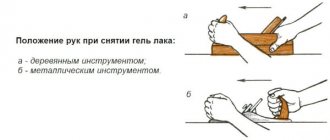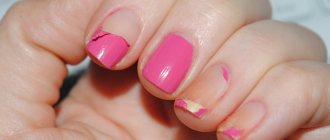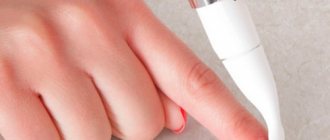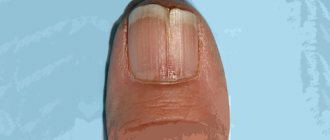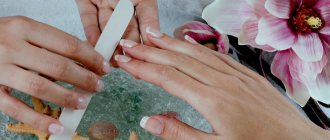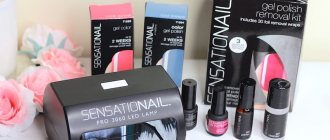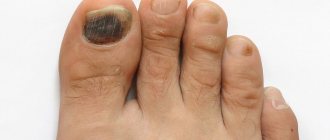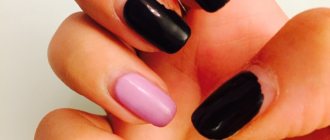Just recently, a reader came to me asking why the gel polish on her nails cracks like a cobweb just a few days after application. I myself have not encountered this, so I decided to conduct an investigation and find out from professionals and those who have encountered this problem about the reasons for this phenomenon.
To begin with, it is worth noting that it is the top coat that cracks on the nails, and not the gel polish itself, so this can be observed both on a regular color coating and on designs, pigments and on top of other materials.
Why does gel polish crack on nails - what is it?
We are talking about a unique product that is now widely used by manicurists. To be more precise, this is an unusual varnish with specific components. The advantages of this tool include:
- not erasable,
- impossibility of accidental mechanical removal,
- ability to decorate nails for at least 14 days,
- color variety.
But it happens that the gel polish on your nails cracks. This phenomenon is not pleasant, it spoils the aesthetic appearance of the manicure, so it is important to know its causes. The popularity of this type of manicure is justified, because the main working material is easy to apply and is characterized by increased strength. It is absorbed by the pores and therefore does not negatively affect the condition of the nails. Moreover, gel polish can last a long time, and most importantly, it is not contraindicated for use in various situations.

How to restore a cracked nail

A cracked nail can be repaired, no matter where it is damaged, with:
- polygel, biogel, gel-jelly of thick consistency, base with acrylic powder for small cracks;
- acrylic;
- fiberglass;
- silk or fiberglass.
The repair procedure looks like this:
- Remove the old coating, possibly down to the base layer or in such a way that there is no artificial material left on the nail (the crack should be visible).
- The plate is wiped with a degreaser.
- Then a primer is applied and after it dries in air, a thin layer of base product is applied, which is polymerized.
- Using an orange stick, take a portion of the gel and apply it to the place where the crack is located.
- The material is leveled with patting movements, using a flat brush dipped in degreaser and lightly wrung out.
- The material is dried in a lamp.
- If there is a sticky layer on it, remove it.
- The nail needs to be filed to remove excess material.
- Dust is removed with a lint-free cloth and further coating can be applied as usual.
If fiberglass is used, there should be a damp base underneath it. The reinforcing film is separated from the substrate and placed on the crack. And on top you need to apply another layer of base and dry it in a lamp. The nail is strengthened in the same way and the defect is eliminated with fiberglass. But after drying the material, its excess is cut off with scissors. Then you can use liquid camouflage gel.
Watch the video about options for repairing cracked nails:
Why shellac cracks on nails - non-compliance with technology
The most common reason why shellac cracks on nails is improper organization of the process. Ignoring at least one of the rules is fraught with cracking of the varnish, which does not look aesthetically pleasing. The most common mistakes of masters are:
- incomplete cuticle removal,
- neglecting the plate grinding stage,
- using the cream before the coating procedure itself,
- not completely dry nails,
- residues of fat elements on the surface.
It is also considered a violation of technology to apply too thick/thin a layer of varnish acting as a base, the presence of foreign elements, dust, and, last but not least, the use of low-quality materials.

Time factor
Cracking after application
Immediately after application, the gel polish may crack as a result of:
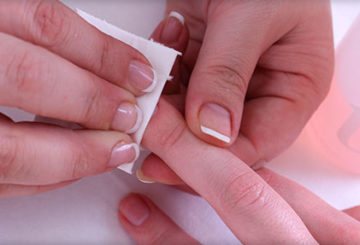
- use of low-quality accessories and materials;
- improper preparation for the procedure;
- violations of execution technique.
Cracking begins a few hours after the procedure.
Cracking on the second day
On the second day, cracks appear on the nails if the gel polish is applied to a woman who started menstruating the day before.
Cracks form when a master uses low-quality gel polish or neglects the rules of manicure technique.
Cracked gel polish on nails, other reasons
External factors are of no small importance for the condition of the gel coating. It makes sense to think about them if the master is sure that he did everything right, but the gel on the nails still cracks. The reason may lie in the pathological thinness of the nails and their softness. Gel-based varnish always doesn’t adhere well to such plates. If the problem associated with weakening nails is relevant for you, then it is better to first treat and strengthen them. As an addition, the specialist may recommend applying a special strengthening varnish.
Don't know why the gel polish on your nails is cracking? Think about it, maybe you took antibiotics the day before? This could well affect the quality and durability of the decorative coating. Always remember that some substances are eliminated from the body, including through the skin and nails. This may also be due to diseases of the main digestive organ (stomach), cardiovascular, and endocrine systems. The onset of menstruation also explains why the finish of the gel on nails cracks.

The manicurist should warn you - damage to the integrity of the coating can be caused by contact with chemically active substances contained in detergents and some creams. This can also happen due to the fault of the master, for example, if he uses materials from different production lines, which creates a “conflict” of components. There are cases of individual intolerance to manicure products. Under such circumstances, it should be completely and immediately abandoned. And lastly, using low quality gel polishes always leads to negative consequences.
Pregnancy
While carrying a child, a woman’s body behaves differently than before. Often girls observe accelerated nail growth. This leads to rapid cracking of the varnish. The body may react to the gel coating as a foreign component, which will also negatively affect its appearance.

Experts do not recommend that women use gel coating during pregnancy, especially in the first and last trimester, as well as after childbirth - the first 6 months. Due to hormonal imbalance, expectant and new mothers react quite unpredictably to strong odors and chemicals. During the procedure, headaches, weakness and nausea may occur.
Why gel on nails cracks - ways to prevent it
The reason why the gel polish on the nails cracked is of great importance, but often simply following the technology and simple rules of “operation”, the attractiveness of the coating can be extended. Always remember to treat your manicure with care. Try not to expose your nails to chemicals or negative external factors.
Proper removal of the coating made from gel is of particular importance. Under no circumstances should you scrape off the varnish with metal objects or chew it off. For these purposes, a special liquid is used, it is called Remover. A cotton pad is moistened with it, which is then applied to the nail plate and left for a while. Each finger is wrapped in foil, you need to wait 5-10 minutes. After their expiration, the “uniform” is removed, the remnants of the gel polish are removed with a special wooden stick (pusher).
If you always adhere to simple rules, then a beautiful manicure will delight you for at least 2 weeks. By the way, it is also not recommended to walk for a very long time with such a coating.
Incorrect application
- First of all, this concerns the work of the master: when creating the manicure, the technological process was disrupted.
- The reasons may be poor quality of the material, the use of poor tools, the use of expired varnish, as well as base and top coats from different manufacturers.
- Durability depends on the quality of the products. According to experts, it is better to use products with natural ingredients. “Two in one” is much worse than individual products.
- The surface of the nail was subjected to unprofessional treatment, which caused cracked varnish. The thin skin must be removed along with the cuticle. If the master ignores this rule, there will never be a reliable adhesion of the gel to the nail plate. After a week, the gel polish will begin to peel off.
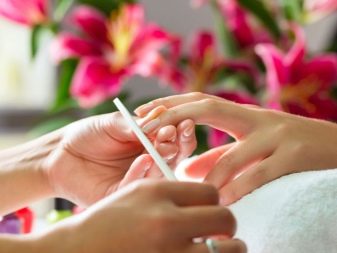
The manicure was applied to a damp coating. Perhaps the nails were not dried well. According to technology, each layer of applied varnish must be thoroughly dried. If the ultraviolet lamp has low power, simply increase the drying time. Degreasing of the nail plate was performed incorrectly: a special spray was applied directly to the surface without the use of napkins or cotton pads
Degreasing can be done with any nail polish remover that contains acetone. If the nail has been poorly polished, the surface will not be perfectly smooth, which is important for applying a manicure. There is no varnish on the ends. Dust may have gotten onto the undried layer.
To prevent this from happening, the master’s workplace must always be clean, and unnecessary items must be removed. The base coat applied was very thick. The colors and top were chosen incorrectly.

Defect prevention measures
To prevent the appearance of cracks in the coating or “living” nail, you should:
take care of your nail plates, take vitamins to strengthen them; avoid damaging them when performing a manicure to avoid cuts and thinning; when giving shape, take into account the characteristics of the nails, do not try to narrow them at the cost of cutting off the lateral lines and injuring the growth points; It is good to remove the keratinized part of the cuticle; try not to allow gel polish to drip onto the skin, as this area can become the beginning of a crack; use only high-quality coating products; strictly follow the sequence of the procedure; do not use a lot of material; strengthen with acrylic powder or gel for long lengths; apply elastic rubber under a strong base, even with soft nails; do not tear off the old coating, but remove it using a special liquid or by carefully cutting it off with a hardware router; do housework that involves contact with water and household chemicals, only wearing gloves; postpone performing a beauty procedure to another time during menstruation, illness or simply not feeling well; adjust your manicure in a timely manner, do not wear it for longer than 2-3 weeks; In winter, wear gloves or mittens outside so that the coating is not exposed to additional temperature effects; Do not bite your nails or pick at hard surfaces.
In most cases, cracks can be prevented. But you need to have good gel polishes, base, top, carefully prepare your nails for manicure, learn how to do everything correctly. It is worth considering that the gel polish coating, although durable, is also subject to mechanical stress. Therefore, any work should be done with gloved hands.
